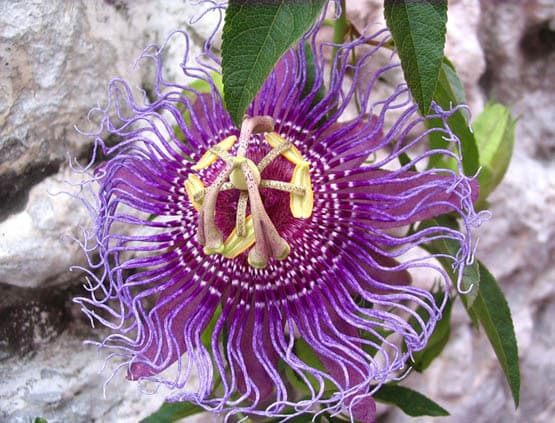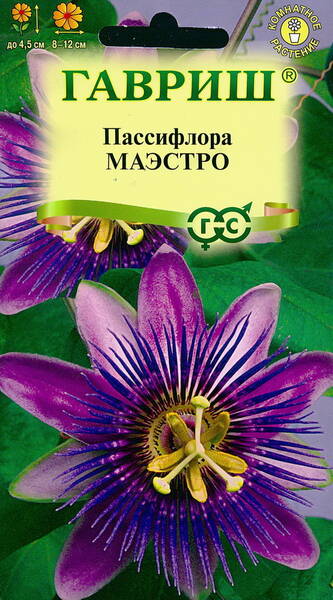A very decorative, fast-growing liana up to 4.5 m long. The flowers are lilac-white, 8-12 cm in diameter. The fruits are red-brown, very tasty.
This is an excellent climbing plant for the home or winter garden. It grows quickly, is distinguished by its vitality, magical aroma, blooms abundantly and for a long time. It is easy to grow and feels good even in small pots.
The plant is very photophilous. It needs regular spraying and ventilation. In summer, it is recommended to take the plants out into the garden or onto the balcony.
Well-drained, neutral or slightly alkaline soils are required. During the period of active growth (until August), abundant watering and weekly fertilizing are necessary, but stagnant moisture should not be allowed.
Before frost, the plants are returned to indoor conditions. In March, the lateral shoots are shortened by 3-5 buds. Propagated by seeds, which are soaked in water for a day, then sown in soil. The depth of planting is 2-5 mm. The optimum temperature for germination is +20+24°C.
Some seeds can germinate for up to 12 months. Picking is done in the phase of the first pair of true leaves (seedlings are not deepened, even if they have stretched out).
Overdrying of the substrate is unacceptable, so the crops are covered with glass or transparent film, which is removed as the shoots appear. The shoots need a 12-hour daylight, additional lighting is used if necessary.

* Propagation and care.
It is recommended to propagate Passiflora by seeds in February-March.
The best, faster shoots are produced by fresh Passiflora seeds: freshly picked ones usually sprout in 2 weeks, and old "stale" ones - in a month or more.
Experts advise to speed up the sprouting by lightly rubbing passionflower seeds on sandpaper, and then immersing them in citrus juice (orange, lemon, grapefruit) for 12-20 hours.
After this seeds are sown in a loose substrate, for example:
- in a mixture of equal parts peat, soil for seedlings and vermiculite;
- in neutral coconut fibre;
- in a mixture of leaf, peat, humus soil and sand in equal parts.
The depth of planting seeds should be equal to three of their diameters.
The crops are sprayed with water from a spray bottle and covered with glass.
For successful germination of Passiflora seeds, it is important to maintain moderate soil moisture and high air humidity, ventilate the crops more often, regularly wiping off the condensation on the glass and turning it over. The temperature range for germinating passionflower seeds is +20+25 °C.
Pruning stimulates flowering.
At the beginning of active growth, in March, it is necessary to cut off old and drying shoots and feed the plants.
Passiflora blooms only on new shoots, so its pruning promotes the formation of beautiful dense foliage and stimulates abundant flowering.
After flowering and fruiting, pruning is carried out again, removing excessively long shoots that have naturally become bald. The easiest way is to remove the plant from the support and completely remove half or even 3/4 of the length of the long shoots with a sharp knife or pruning shears.
The shoots should never be cut to the level of the main stem, they are shortened above the eighth node and weak shoots are cut out, often growing from the base of the stem. Then curl the plant back onto the support.
To make the plant look decorative, a wireframe is usually made in the form of a semicircle, sticking the ends of the support into the ground. As the young shoots grow, they are carefully wrapped around the wire, and the plant always has a very beautiful appearance, since the young shoots cover the old bald vines.
It really looks very impressive, and the blooms are simply stunning.
A very important point: the volume of the crown directly depends on how big the pot is.
The plant needs to be replanted every year, but it is better to choose not very large pots since in a few years you can reach the tubs. To make the plant more beautiful, old "bald" shoots should be cut off, leaving 10-15 centimeters, on them new shoots with buds will appear.
You have grown passionflower. What next?
You will need a lot of space. No matter what kind of Passiflora you managed to grow. At the same time, all branches should be well lit, otherwise the leaves will fall off, and bare stems are not a good decoration.
The first thing to do is to transplant the plant from the transport soil into a loose light mixture (do not forget about drainage!) and carefully remove the fragile vines from the support. You can use ready-made soil, for example, a mixture for cacti will do.
Find the sunniest window...
The cacti will have to make room - from now on this place will be occupied by passionflower. Curtains will no longer be needed - the growth of young shoots can be up to 15 cm per day, and the green curtain will very soon cover the entire window.
The pot is smaller (no more than 30 cm in diameter).
Firstly, in a large pot the plants "grow fat" and do not bloom. And secondly, a small pot will help limit the growth of large passion flowers - otherwise they will not fit on the window!
Moderate watering and constantly humid air are the conditions necessary for the well-being of passion flowers. Dry air can lead to damage by red spider mites.
Fresh air, but not a draft!
In winter, when airing, direct the flow of cold air away from the plant. Place the pots on the windowsill on stands so that the soil does not get too cold.
Pruning promotes flowering, since flowers appear on new shoots. After flowering and fruiting, excessively long and bare shoots are usually removed. Shoots cannot be cut to the main stem, it is necessary to leave a quarter of their length (or at least 3-4 cm). Instead of pruning, you can turn the shoot DOWN if you don't want to prune it. This causes new shoots to form from dormant buds.












